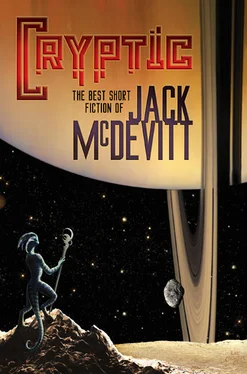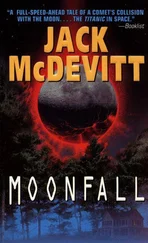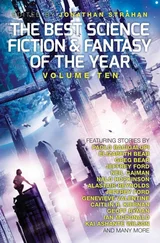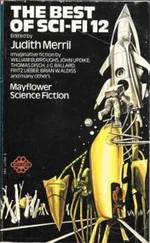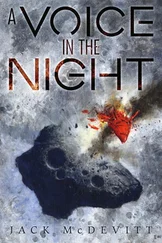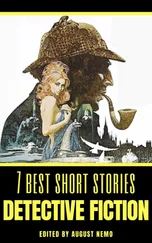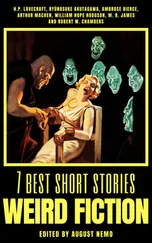Джек Макдевитт - Cryptic - The Best Short Fiction of Jack McDevitt
Здесь есть возможность читать онлайн «Джек Макдевитт - Cryptic - The Best Short Fiction of Jack McDevitt» весь текст электронной книги совершенно бесплатно (целиком полную версию без сокращений). В некоторых случаях можно слушать аудио, скачать через торрент в формате fb2 и присутствует краткое содержание. Издательство: Subterranean Press, Жанр: Фантастика и фэнтези, на английском языке. Описание произведения, (предисловие) а так же отзывы посетителей доступны на портале библиотеки ЛибКат.
- Название:Cryptic: The Best Short Fiction of Jack McDevitt
- Автор:
- Издательство:Subterranean Press
- Жанр:
- Год:неизвестен
- ISBN:нет данных
- Рейтинг книги:3 / 5. Голосов: 1
-
Избранное:Добавить в избранное
- Отзывы:
-
Ваша оценка:
- 60
- 1
- 2
- 3
- 4
- 5
Cryptic: The Best Short Fiction of Jack McDevitt: краткое содержание, описание и аннотация
Предлагаем к чтению аннотацию, описание, краткое содержание или предисловие (зависит от того, что написал сам автор книги «Cryptic: The Best Short Fiction of Jack McDevitt»). Если вы не нашли необходимую информацию о книге — напишите в комментариях, мы постараемся отыскать её.
Cryptic: The Best Short Fiction of Jack McDevitt — читать онлайн бесплатно полную книгу (весь текст) целиком
Ниже представлен текст книги, разбитый по страницам. Система сохранения места последней прочитанной страницы, позволяет с удобством читать онлайн бесплатно книгу «Cryptic: The Best Short Fiction of Jack McDevitt», без необходимости каждый раз заново искать на чём Вы остановились. Поставьте закладку, и сможете в любой момент перейти на страницу, на которой закончили чтение.
Интервал:
Закладка:
They were jointed bipeds, somewhat larger than we are. We can sit in their chairs and those of us who are tall enough to be able to see through their windshields can drive their cars. Our sense of the place was that they’d left the day before we came.
It’s a city of domes and minarets. The homes are spacious, with courtyards and gardens now run to weed. And they were fond of games and sports. We found gymnasiums and parks and pools everywhere. There was a magnificent oceanfront stadium, and every private home seemed filled with playing cards and dice and geometrical puzzles and 81-square checkerboards.
They had apparently not discovered photography; nor, as far as we could determine, were they given to the plastic arts. There were no statues. Even the fountain lacked the usual boys on dolphins or winged women. It was instead a study in wet geometry, a complex of leaning slabs, balanced spheres, and odd-angled pyramids.
Consequently, we’d been there quite a while before we found out what the inhabitants looked like. That happened when we walked into a small home on the north side, and found some charcoal etchings.
Cats , someone said.
Maybe. The following day we came across an art museum and found several hundred watercolors, oils, tapestries, crystals, and so on.
They are felines, without doubt, but the eyes are chilling. The creatures in the paintings have nevertheless a human dimension. They are bundled against storms; they gaze across plowed fields at sunset; they smile benevolently (or pompously) out of portraits. In one particularly striking watercolor, four females cower beneath an angry sky. Between heaving clouds, a pair of full moons illuminate the scene.
This world has no satellite.
Virtually everyone crowded into the museum. It was a day of sighs and grunts and exclamations, but it brought us no closer to an answer to the central question: where had they gone?
“Just as well they’re not here,” Turner said, standing in front of the watercolor. “This is the only living world anyone has seen. It’s one hell of a valuable piece of real estate. Nice of them to give it to us.”
I was at the time standing across the gallery in front of a wall-sized oil. It was done in impressionistic style, reminiscent of Degas: a group of the creatures was gathered about a game of chess. Two were seated at the table, hunched over the pieces in the classic pose of the dedicated player. Several more, half in shadow, watched.
Their expressions were remarkably human. If one allowed for the ears and the fangs, the scene might easily have been a New York coffeehouse.
The table was set under a hanging lamp; its hazy illumination fell squarely on the board.
The game was not actually chess, of course. For one thing, the board had 81 squares. There was no queen. Instead, the king was flanked by a pair of pieces that vaguely resembled shields. Stylized hemispheres at the extremes of the position must have been rooks. (Where else but on the flank would one reasonably place a rook?)
The other pieces, too, were familiar. The left-hand Black bishop had been fianchettoed: a one-square angular move onto the long diagonal, from where it would exercise withering power. All four knights had been moved, and their twisted tracks betrayed their identity.
The game was still in its opening stages. White was two pawns up, temporarily. It appeared to be Black’s move, and he would, I suspected, seize a White pawn which had strayed deep into what we would consider his queenside.
I stood before that painting, feeling the stirrings of kinship and affection for these people and wondering what immutable laws of psychology, mathematics, and aesthetics ordained the creation of chess in cultures so distant from each other. I wondered whether the game might not prove a rite of passage of some sort.
I was about to leave when I detected a wrongness somewhere in the painting, as if a piece were misplaced, or the kibitzers were surreptitiously watching me . Whatever it was, I grew conscious of my breathing.
There was nothing.
I backed away, turned, and hurried out of the building.
I’m a symbologist, with a specialty in linguistics. If we ever do actually find someone out here to talk to, I’m the one who will be expected to say hello. That’s an honor, I suppose; but I can’t get Captain Cook entirely out of my mind.
By the end of the first week, we had not turned up any writtenmaterial (and, in fact, still haven’t) other than a few undecipherable inscriptions on the sides of buildings. They were even more computerized than we are, and we assumed everything went into the data banks, which we also haven’t found. The computers themselves are wrecked. Slagged. So, by the way, is the central power core for the City. Another mystery.
Anyhow, I had little to do, so yesterday I went for a walk in the twilight with Jennifer East, a navigator and the pilot of the other lander. She’s lovely, with bright hazel eyes and a quick smile. Her long tawny hair was radiant in the setting sun. The atmosphere here has a moderately high oxygen content, which affects her the way some women are affected by martinis. She clung to my arm, and I was breathlessly aware of her long-legged stride.
We might have been walking through the streets of an idealized, mystical Baghdad: the towers were gold and purple in the failing light. Flights of brightly-colored birds scattered before us. I half-expected to hear the somber cry of a ram’s horn, calling the faithful to prayer.
The avenue is lined with delicate, graybarked trees. Their broad, filamented leaves sighed in the wind, which was constant off the western mountains. Out at sea, thunder rumbled.
Behind the trees are the empty homes, no two alike, and other structures that we have not yet begun to analyze. Only the towers exceed three stories. The buildings are all beveled and curved; right angles do not exist. I wonder what the psychologists will make of that.
“I wonder how long they’ve been gone?” she said. Her eyes were luminous with excitement, directed (I’m sorry to say) at the architecture.
That had been a point of considerable debate. Many of the interiors revealed a degree of dust that suggested it could not have been more than a few weeks since someone had occupied them. But much of the pavement was in a state of disrepair, and on the City’s inland side, forest was beginning to push through.
I told her I thought they’d been around quite recently. “Mark,” she said, staying close, “I wonder whether they’ve really left.”
There was nothing you could put in a report, but I agreed that we were transients, that those streets had long run to laughter and song, that they soon would again, and that it would never really be ours.
She squeezed my arm. “It’s magnificent.”
I envied her; this was her first flight. For most of us, there had been too many broken landscapes, too much desert.
“Olszewski thinks,” I said, “that the northern section of the City is almost two thousand years old…. They’d been here a while.”
“And they just packed up and left.” She steered us out of the center, angling toward the trees, where I think we both felt less conspicuous.
“It’s ironic,” I said. “No one would have believed first contact would come like this. They’ve been here since the time of Constantine, and we miss them by a few weeks. Hard to believe, isn’t it?”
She frowned. “It’s not believable.” She touched one of the trees. “Did you know it’s the second time?” she asked. I must have looked blank. “Twenty-two years ago the Berlin tracked something across the face of Algol and then lost it. Whatever it was, it threw a couple of sharp turns.” We walked silently for several minutes, crossed another avenue, and approached the museum. “Algol,” she said, “isn’t all that far from here.”
Читать дальшеИнтервал:
Закладка:
Похожие книги на «Cryptic: The Best Short Fiction of Jack McDevitt»
Представляем Вашему вниманию похожие книги на «Cryptic: The Best Short Fiction of Jack McDevitt» списком для выбора. Мы отобрали схожую по названию и смыслу литературу в надежде предоставить читателям больше вариантов отыскать новые, интересные, ещё непрочитанные произведения.
Обсуждение, отзывы о книге «Cryptic: The Best Short Fiction of Jack McDevitt» и просто собственные мнения читателей. Оставьте ваши комментарии, напишите, что Вы думаете о произведении, его смысле или главных героях. Укажите что конкретно понравилось, а что нет, и почему Вы так считаете.
